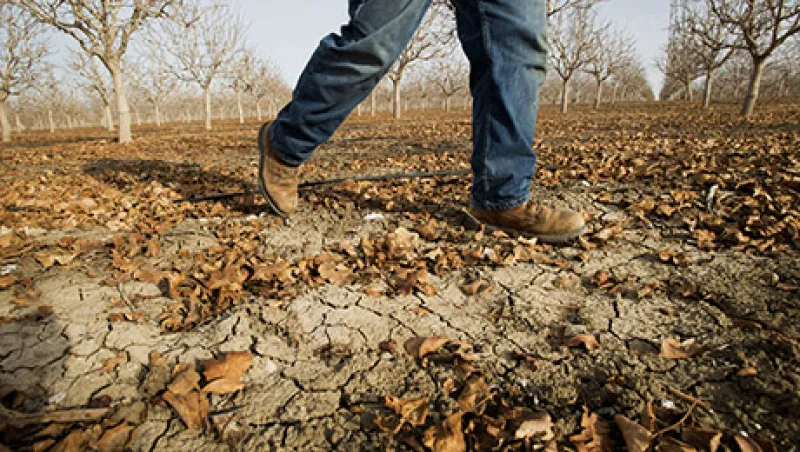There seems to be no end in sight to California’s catastrophic drought, now in its third year. Nearly all reservoirs throughout the state are holding a fraction of their total capacity. Last week voters passed a bond measure to spend $7.12 billion to upgrade the Golden State’s outdated water infrastructure. California’s water bond, or Proposition 1, may just be a drop in the bucket, however, in shoring up the state’s water needs, given its anticipated population growth. The American Society of Civil Engineers estimated in 2013 that California, which if it were a nation would be the world’s eighth-largest economy, needs $39 billion in drinking water infrastructure and $29.9 billion in wastewater infrastructure over the next 20 years.
“The bond measure demonstrates that there’s not only a taxpayer appetite but that it’s an investable space,” says David Rose, senior vice president of equity research and water and renewable energy solutions at Wedbush Securities in Los Angeles. “Also, it shows that governments are willing to spend money, so I think you’ll see more institutional money flow to the space — no pun intended.”
California projects population growth of 17.7 million residents — equivalent to the current population of greater Los Angeles — between 1995 and 2025, driven by immigration. It’s expected to grow from 12 percent of the U.S. population to 15 percent by 2025, according to the U.S. Census Bureau. To make matters worse, because of the arid climate across much of the state, California absorbs significantly more water than the rest of the U.S. Californians consume an average of 181 gallons per capita per day, compared with 72 gallons a day by residents of the Northeast and 82 gallons in the Midwest, according to data from the U.S. Drought Monitor and the U.S. Geological Survey. In California’s largest city, the Los Angeles Department of Water and Power plans to increase spending on capital projects by 8 percent in fiscal year 2014–’15, to $722 million from $670 million two fiscal years prior, according to Jane Galbraith, a spokeswoman with the department.
Suffice it to say, funds are beginning to go toward alleviating the effects of the drought.
Among the biggest investment opportunities are in infrastructure projects engaged in desalination and wastewater recycling, known as the so-called toilet-to-tap system, which turns sewage water into drinking water, says Simon Gottelier, senior portfolio manager and director of $4.7 billion Impax Asset Management Group, a London-based firm that specializes in green and sustainable investment. At the moment, California has 17 desalination plants in planning stages. One of them, the $1 billion Carlsbad desalination plant, on track to be the largest in the Western Hemisphere, is more than halfway complete and on schedule to be ready for commercial operation by the end of 2016. By 2020 the plant, designed and constructed by Boston-headquartered Poseidon Water, will be able to produce 50 million gallons of water a day, about 7 percent of San Diego County’s water supply, while costing twice as much as pumping water from a lake or river.
“The creation of drinking water from the sea has always been too expensive,” Gottelier says, though “lower energy prices caused by fracking and the abundance of natural gas have precipitated more interest in the sector.” Catching the wave is California American Water, a locally run subsidiary of Voorhees, New Jersey–headquartered public utility American Water. The company has planned desalination slant wells that go beneath the ocean floor to draw water to replace water pumped from the Carmel River, which is home to threatened fish and frog species.
On the wastewater recycling front, the Orange County Water District is spending $142 million to expand its wastewater recycling project by 30 percent. It’s expected to produce 100 million gallons of water daily by the end of 2015. Some six hours’ drive time north, the Silicon Valley Advanced Water Purification Center, which supplies Apple’s new headquarters in Cupertino, uses Xylem’s Wedeco technology to turn wastewater into nonpotable water used for irrigation and landscaping. Xylem, a Rye Brook, New York–based water technology company that runs a factory in Irvine, California, has a water infrastructure backlog totaling $656 million, of which $380 million will be delivered during fourth-quarter 2014, chief financial officer Michael Speetzen said in a recent conference call. Gottelier and Wedbush’s Rose both named Xylem as among the companies that stand to see the biggest inflows from California. Another company that should see a steady stream of drought-related business is valve and water-control manufacturer Pentair, headquartered in Schaffhausen, Switzerland, with U.S. operations based in Golden Valley, Minnesota. Pentair chair and CEO Randall Hogan said during its third-quarter 2014 earnings conference call that the global water infrastructure developer ended the period with a $1.3 billion backlog.
Water metering might also see some business from California. Two publicly traded water meter makers are Atlanta-headquartered Mueller Water Products and Badger Meter, based in Milwaukee. Eventually, California municipalities will be required to meter water use. At present, some cities charge residents a flat monthly fee for water use. The city of Woodlake, located in the farming-heavy San Joaquin Valley, is tapping into a $4 million pool of U.S. Department of Agriculture loans and grants to shift away from its monthly residential flat rate of $28.50 and, for the first time, install water meters in homes and businesses. The prospect of paying by the gallon may encourage people to conserve more water. Cutting back domestic demand, however, is but a small ripple. Residential use only accounts for 1 percent of total water use, with 60 percent of that going toward watering landscaping. Most water is used for irrigation and power generation.
In any event, domestically and internationally, water-focused investments will only gather steam. “California, Texas and Brazil are really faced with these water challenges, and it may not be evident on a global basis,” says Rose. “So when you add up all of the different regions, the impact from some of this investment is pretty material.”






